Download Best Case Software Version 26
SPSS 26 comes in both a new and the archetype interface. We downloaded and tested the new interface. This review walks you through our main findings.
- SPSS 26 - Which "Subscription" Am I On?
- SPSS 26 - Data View & Variable View Tabs
- SPSS 26 - Menus & Dialogs
- SPSS 26 Output Tab - Tables & Charts
- SPSS 26 - The Analyze Itemize
- SPSS 26 - Conclusions
SPSS 26 - Which "Subscription" Am I On?
When downloading SPSS 26, we're offered both the new equally well as the classic interface. Curiously, the IBM website mentions "SPSS Subscription" rather than "SPSS 26".
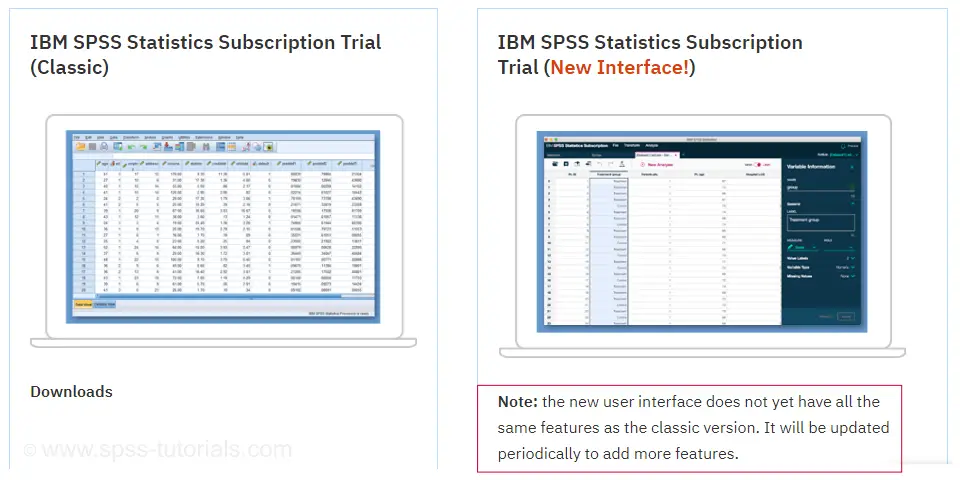
Before downloading it, nosotros're already warned that the new interface "does not yet have notwithstanding features" as the archetype version. Well, ok. There's probably some tiny details they still need to work on. But they wouldn't launch a half-baked software parcel. Would they?
Anyway, we installed both versions and after doing so, our SPSS statistics directory looks similar beneath.
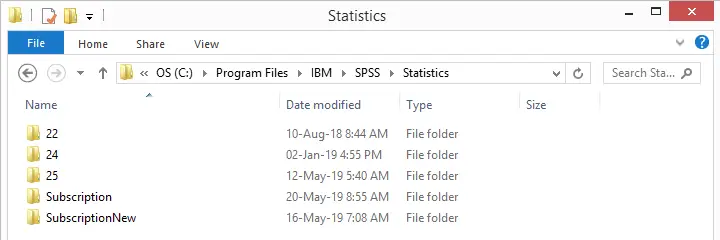
I was expecting a subfolder named 26 just instead I've Subscription and SubscriptionNew for the classic and new interfaces. It kinda makes me wonder is this really SPSS 26? For SPSS 25 and older, this was ever crystal clear: these versions mention their version number when starting or closing the plan. In the middle of a session, navigating to  shows the exact release such equally 25.0.0.i. Alternatively, running the show license. syntax would likewise do the trick.
shows the exact release such equally 25.0.0.i. Alternatively, running the show license. syntax would likewise do the trick.
In the new interface, none of those options come up with anything but "IBM SPSS Statistics". However, when digging into the backend subfolder, we constitute stats.exe, the actual application. And when we hovered over the file, nosotros saw this:
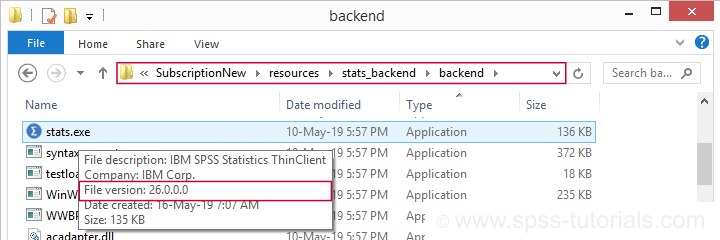
SPSS 26 indeed. But why do I even want to know my verbal version number? Well,
- if something does not work in my SPSS version, I want to Google something similar "SPSS 26 font size data editor". If I tin't add my version number to that, I'll get solutions for other SPSS versions that don't solve my problem.
- Second, if I want to help out my clients, their version numbers tell me what will (not) piece of work for them.
- And -finally- the IBM license central center merely offers me an authorization code for IBM SPSS Statistics Desktop 26. It does not mention any "Subscription" (see below).
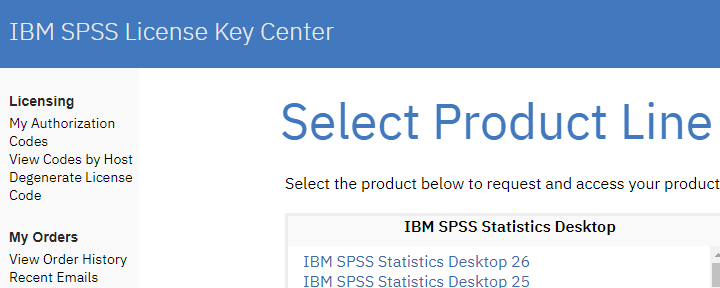
SPSS 26 - Data View & Variable View Tabs
Anway, we downloaded and installed the SPSS 26 with the new interface. After opening some data, nosotros get the data view tab shown below.
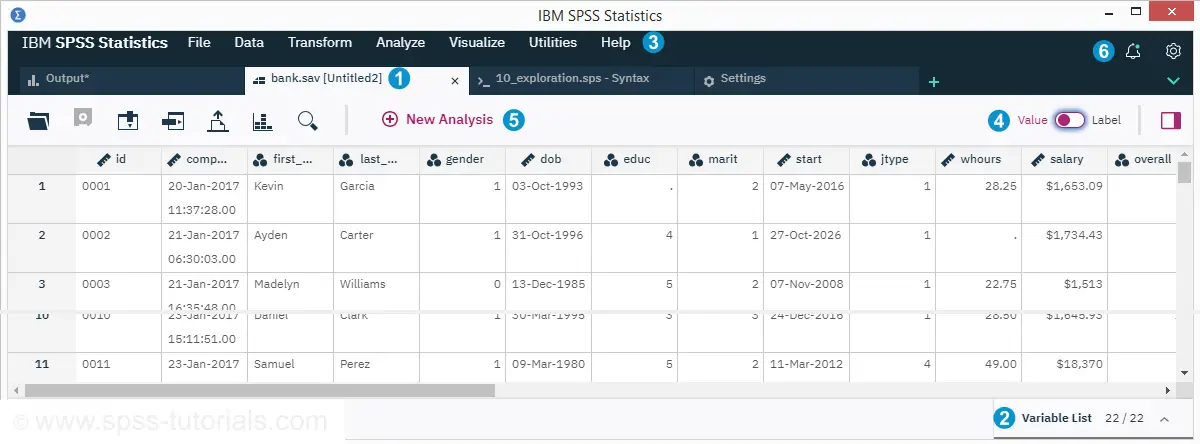
 The new interface is based on tabs rather than (information, syntax and output) windows. As nosotros'll see in a infinitesimal, settings and dialogs also come as tabs.
The new interface is based on tabs rather than (information, syntax and output) windows. As nosotros'll see in a infinitesimal, settings and dialogs also come as tabs.
 Variable view is below data view and slides up upon clicking information technology. We didn't notice whatever shortcut for doing so.
Variable view is below data view and slides up upon clicking information technology. We didn't notice whatever shortcut for doing so.
 The and menus are absent. I suppose they'll be added afterward. Just for now, this actually is a huge trouble.
The and menus are absent. I suppose they'll be added afterward. Just for now, this actually is a huge trouble.
 The value/label switch does non toggle between values and value labels only -rather- between variable names and variable labels.
The value/label switch does non toggle between values and value labels only -rather- between variable names and variable labels.
 An Analyze Catalog has been added.
An Analyze Catalog has been added.
 There's notifications and settings icons. However, these settings don't include the essential settings under
There's notifications and settings icons. However, these settings don't include the essential settings under  in previous SPSS versions. These seem unavailable in the new interface.
in previous SPSS versions. These seem unavailable in the new interface.
SPSS 26 - Data View Issues
Fifty-fifty this very first exploration of the new interface resulted in some serious problems.
- First off, my laptop has a 1920 by 1080px screen resolution. Every bit a result, the font sizes are manner also small on my screen. Since there'south no menu -the only way to ready larger font sizes- this makes the new information view pretty useless for me.
- Second, it seems impossible to have multiple syntax tabs open simultaneously. Whenever I open some other syntax file, the open syntax tab closes, request me whether to save its contents.
- Third, my OUTPUT Close command
triggers the fault that information technology's no longer available. That sucks. I always start new projects with closing all open output and datasets. Some of my clients do the same.
- Quaternary, I like to toggle a lot between data view and variable view only -as mentioned- the Ctrl + t shortkey no longer works.
SPSS 26 - Variable View
In SPSS' new interface, variable view is called "Variable List". It'due south in the same tab every bit data view and slides up when clicked. Unfortunately, information technology no longer has the clear and simple structure known from previous SPSS versions.

 The order of variable backdrop has been contradistinct with visibility and measurement levels earlier variable names.
The order of variable backdrop has been contradistinct with visibility and measurement levels earlier variable names.
 The ability to hibernate variables is a welcome new feature. But what's the syntax for doing so? How to hide, say, v1 to v25 merely not v26 to v50? That can't require 25 mouse clicks, correct?
The ability to hibernate variables is a welcome new feature. But what's the syntax for doing so? How to hide, say, v1 to v25 merely not v26 to v50? That can't require 25 mouse clicks, correct?
 Width and columns have been removed. Still, we'll get to those in a minute.
Width and columns have been removed. Still, we'll get to those in a minute.
 The value labels column is finally called "Value Labels" rather than "Values". It at present shows the number of labels divers for each variable .
The value labels column is finally called "Value Labels" rather than "Values". It at present shows the number of labels divers for each variable .
 Apart from the weird Serif fonts in Variable Listing, the alignment looks odd too: information technology seems some column headers are centered with their belongings values left aligned. Together with removing the classic grid, this doesn't contribute to a nice and clear interface.
Apart from the weird Serif fonts in Variable Listing, the alignment looks odd too: information technology seems some column headers are centered with their belongings values left aligned. Together with removing the classic grid, this doesn't contribute to a nice and clear interface.
Nosotros as well noticed that clicking "Blazon" -which either refers to a variable type or format- opens up the dialog shown below.
 Variable type, width and format are shown when clicking "Blazon" in Variable List.
Variable type, width and format are shown when clicking "Blazon" in Variable List. Note that a much better way to set up formats and types are the FORMATS and Change TYPE commands: these can accost many variables in one go and they are replicable.
For the most part, the new menus look similar the old menus merely incomplete and badly reorganized. For instance, let'due south take a wait at as shown beneath.

So why are the most popular analyses and so hard to notice? They're not meant to exist literally "sought later". These analyses should be listed at the top level of Analyze. Instead -withal- Correlate and Regression have actually been removed from information technology.
SPSS 26 - Dialogs
The new dialogs look different from previous versions. Let'south take a expect at the Correlations dialog below.
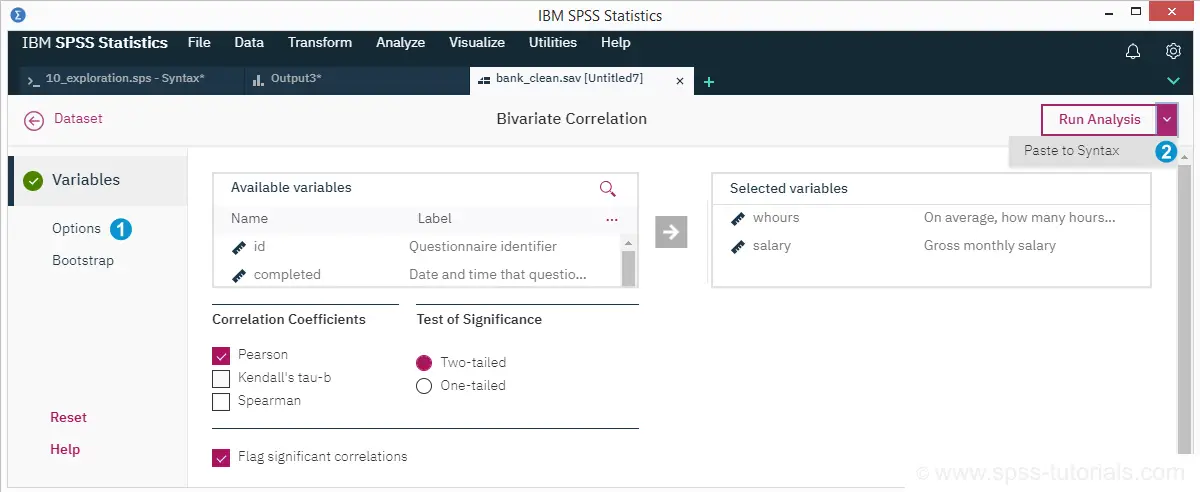
 To our disappointment, the Options are however the same as in previous versions. And they are not adept: regardless of what nosotros need, we always become all significance levels in our output. Conviction intervals for correlations are still non bachelor. Nosotros all the same tin't choose whether we want whatever sample sizes included in our output table.
To our disappointment, the Options are however the same as in previous versions. And they are not adept: regardless of what nosotros need, we always become all significance levels in our output. Conviction intervals for correlations are still non bachelor. Nosotros all the same tin't choose whether we want whatever sample sizes included in our output table.
 The classic functions such every bit Help and Ok are somewhat scattered over the dialog. Unfortunately, "Paste to syntax" is hidden under "Run Analysis" and so this at present takes two clicks instead of 1. The Alt based shortkeys and Esc no longer piece of work either.
The classic functions such every bit Help and Ok are somewhat scattered over the dialog. Unfortunately, "Paste to syntax" is hidden under "Run Analysis" and so this at present takes two clicks instead of 1. The Alt based shortkeys and Esc no longer piece of work either.
SPSS 26 Output Tab - Tables & Charts
After running our assay, nosotros're presented with the output tab shown below.
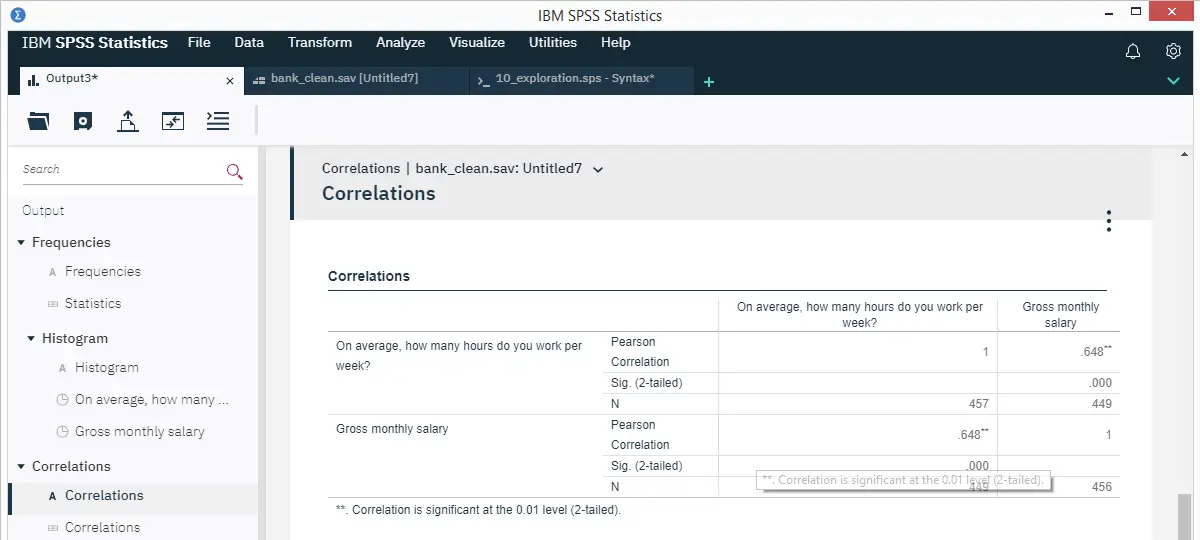
The output outline looks pretty nice and clean. Nonetheless, when correct-clicking an detail, the OMS labels don't testify upwardly. For experienced users, this complicates batch editing tables with OUTPUT MODIFY.
The correlation table itself looks much improve than previous SPSS versions also. Yet, nosotros stumbled upon some issues here too:
- Essential table editing functionality has disappeared. We managed to transpose the table but we can't rearrange its dimensions via Pivoting trays. Coming together APA standards for correlation tables is pretty much impossible from SPSS' new interface.
- Tablelooks no longer seem to piece of work, neither via the carte du jour nor via syntax.
SPSS 26 - Charts
Equally shown below, charts still don't wait too great in SPSS 26.
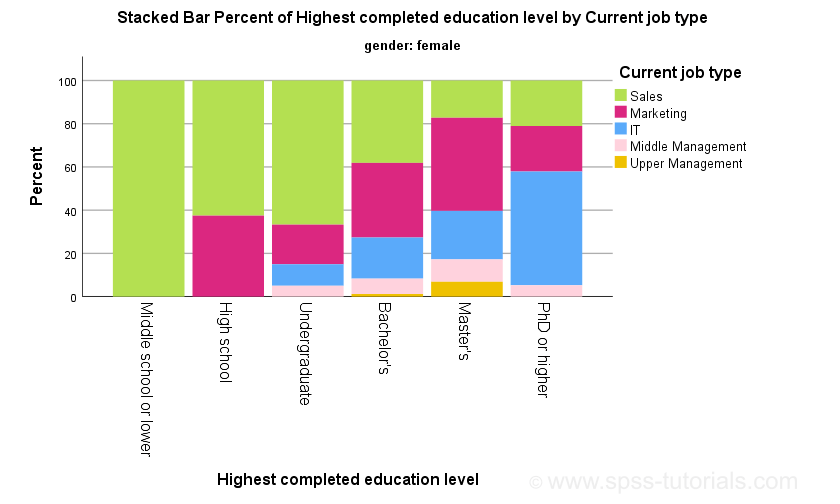
None of the issues discussed in New Charts in SPSS 25 - How Good Are They Really? take been resolved: still no percent sign on the y-axis. Notwithstanding the incorrect championship. And and then on.
More worrying, the SPSS 26 carte du jour only includes the Chart builder. I sure hope the legacy dialogs will soon be added: they are much simpler and result in short and clean syntax that'due south copy-paste-editable.
SPSS 26 - The Analyze Catalog
Another new feature is the Clarify Catalog shown below. It'south attainable from the Data View tab.
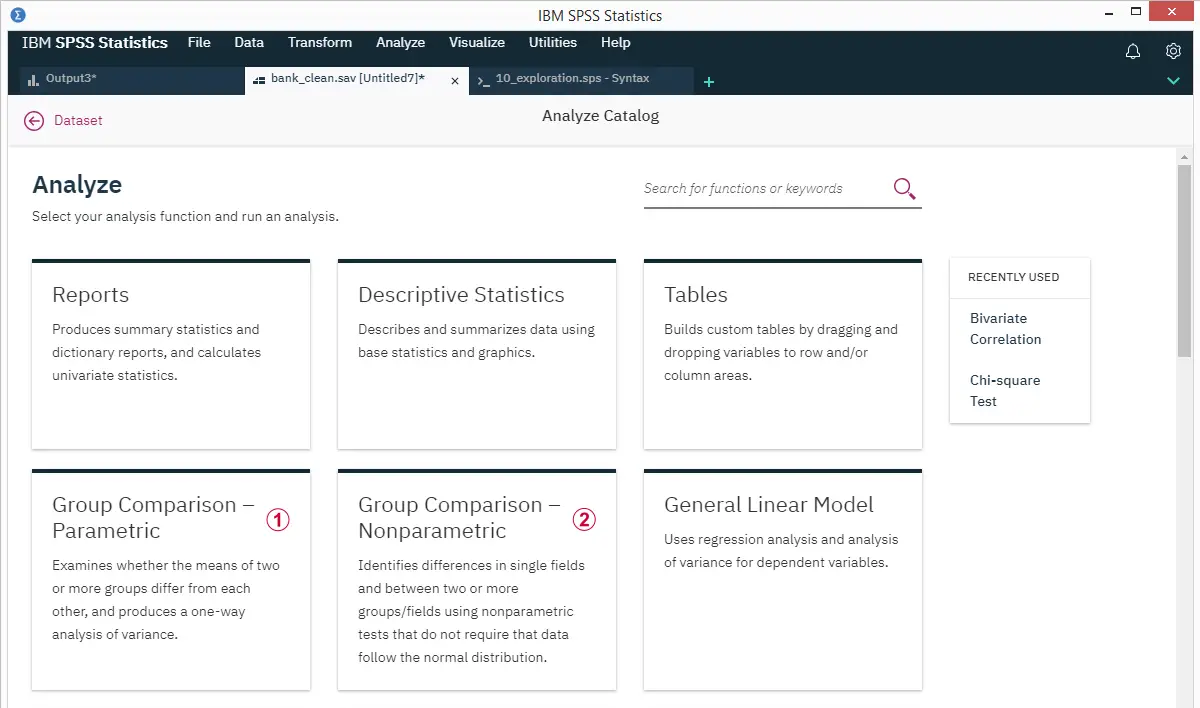
Sadly, the information here is incomplete and inaccurate.
 For example, Group Comparison - Parametric doesn't mention any t-tests. Also, the one sample t-test and paired samples t-test don't compare "ii or more groups". The old clarification -"Compare Means"- did employ to all these tests.
For example, Group Comparison - Parametric doesn't mention any t-tests. Also, the one sample t-test and paired samples t-test don't compare "ii or more groups". The old clarification -"Compare Means"- did employ to all these tests.
 Group Comparing - Nonparametric suggests that parametric tests crave that "data follow the normal distribution". This is wrong: the normality assumption is rarely required for reasonable sample sizes. This is why the Kolmogorov-Smirnov examination is usually useless.
Group Comparing - Nonparametric suggests that parametric tests crave that "data follow the normal distribution". This is wrong: the normality assumption is rarely required for reasonable sample sizes. This is why the Kolmogorov-Smirnov examination is usually useless.
The way I see information technology is that
- SPSS users who don't know what to practice demand educational material optimized for educational purposes and
- SPSS users who know what to do need software optimized for production purposes.
A product that tries to combine these conflicting purposes volition suck at both. This point could hardly be illustrated more convincingly than past the analyze catalog.
Anyhow. One thing I do like about the clarify catalog is the search function. So I don't immediately see ANOVA anywhere in the carte just searching for information technology will surely go me there right away. Right? Well, let'south accept a await at the search results below.

The search results lead me to the Oneway dialog simply not GLM or MEANS. The problem here is that
- Oneway does not include partial eta squared, an effect size measure for ANOVA. We demand to run our ANOVA from Ways or GLM in social club to get it;
- Means, however, does non offering Levene'southward test for homogeneity. We need either Oneway or GLM for that;
- If homogeneity doesn't hold, we may want to interpret the Welch statistic, only bachelor in Oneway.
The existent trouble here is that a consummate ANOVA can't be run from any single dialog or command in SPSS. Instead, we need to run a single analysis multiple times from dissimilar commands if we need all relevant output. And our search results don't fifty-fifty mention MEANS or GLM.
Ok, then let'due south search for a simpler analysis: the Kruskall-Wallis test.

My search doesn't come up up with anything at all. This is because I tested for a common misspelling of "Kruskal-Wallis test". And the search function seems completely unable to handle information technology.
SPSS 26 - Conclusions
Summarizing this review, I recollect SPSS' new interface is worse than the sometime interface
in basically all regards:
- the visual layout -especially of the variable list and dialog tabs- is not equally articulate and simple every bit information technology used to be;
- essential functionality -such as pasting syntax and major analyses- are harder to find;
- most operations require more than mouse clicks than they used to;
- many shortkeys no longer work -although a couple of new ones for navigating and closing tabs have been added.
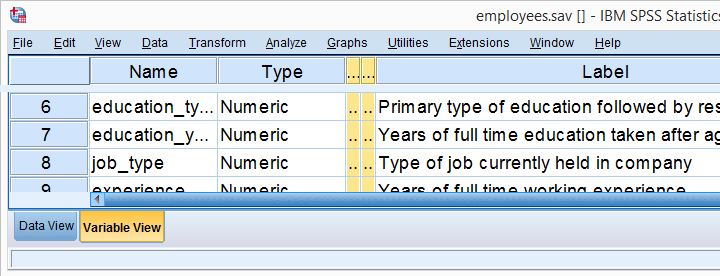 The dainty and clear classic variable view
The dainty and clear classic variable view On summit of that, the new interface is seriously incomplete. A handful of examples are that
- the View and Edit menus are missing;
- there's no Legacy Dialogs under Visualize;
- pivoting trays for rearranging pin table dimensions aren't available;
- OMS information is unavailable from the output outline.
Some of those may be added to the new interface. Just what about first finishing a product and then launching it?
In whatsoever example, I agree that SPSS urgently needs major improvements. This review hinted at a couple of those but there's tons more. Sadly, none of the things SPSS really needs was added to version 26. One thing SPSS did not really need, was a new interface.
If it ain't broken, don't gear up it.
Thanks for reading.
DOWNLOAD HERE
Posted by: vanderbiltderignatim.blogspot.com
Post a Comment for "Download Best Case Software Version 26"